By Christina Butler/Butler Preservation LC for Charleston Empire Properties
December 2020
Mount Pleasant has so many beautiful parks, historic military sites, and waterfront spots that it takes two installments of the Charleston Empire Properties blog series to address all that the East Cooper area has to offer! Moving off of the harbor and inland, visitors will find great seafood and boat slips along Shem Creek, a National Historic Landmark at Snee Farm’s Charles Pinckney House, several newer parks with sports fields near Mount Pleasant’s new suburban communities, and rural escapes like Bull’s Island/Cape Romaine, where development gives way to country northward near Awendaw. There’re even vestiges of a historic hangout spot, Pierate’s Cruze, where a new neighborhood now sits.
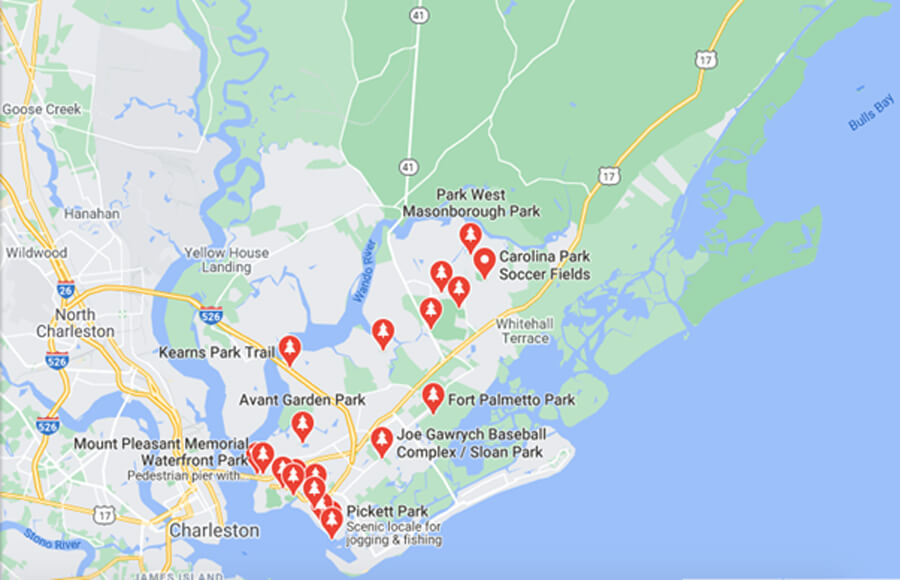
A Plan of the attack of Fort Sulivan, the key of Charlestown, in South Carolina, on the 28th. of June.
Shem Creek cuts into Mount Pleasant from the Cooper River just west of the Old Village and winds its way several miles inland. The mouth is home to Shem Creek Park and a 2,200 foot boardwalk with a boat landing. Shem has long been popular with boaters looking for a safe refuge to tie off.
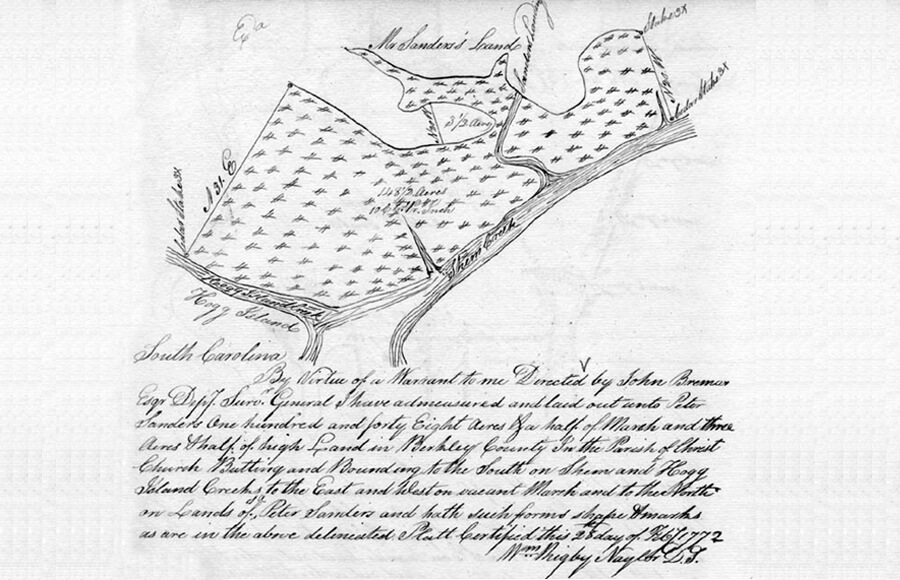
A plat showing lands grants at Shem Creek near Hog Island (in the Cooper River), 1772. South Carolina Department of Archives and History.

An aerial view created by the Town of Mount Pleasant showing the amenities on Shem Creek.
By the 1930s, it became a base for fishermen and shrimpers, and a bridge and shrimp dock were constructed to service the growing iced seafood industry. The Town of Mount Pleasant states that, “shrimping grew into an important harbor industry centered at Shem Creek. In their heyday, seventy shrimp trawlers operated off the docks. By 2011, there were about ten trawlers remaining in the harbor along with a few charter boats.” Today, Shem Creek is best known for recreation and dining and is home to several popular seafood restaurants like Red’s Ice House, a Lowcountry staple for cold beer and outdoor dining; locals pull their boats right up to the restaurant dock to eat, drink, and listen to live music.
Pierate’s Cruze was an eccentrically named park that once sat on the shoreline next to Old Mount Pleasant Village. Today there are several waterfront houses there, along Pierate’s Cruise Drive, next to Center Street Park. The Lowcountry has a rich history of pirates and privateers preying on the coast, but this site is purely a twentieth century invention with an alluring, touristy name. Wealthy northerners Dana and Laird Branch Osgood bought the land, which was once part of the Hilliardsville tract, in 1928, landscape it as a pleasure garden with 1,000 camellias and hundreds of azaleas and opened it to the public in 1943. The newspaper described it that year as, “made up of three parts: Lowcountry jungle, ocean scenery, and camellia blossoms.” Mount Pleasant Historical Commission notes, “It became a popular tourist attraction in the 1940s and 50s. In 1947, the Massachusetts Horticultural Society awarded Mrs. Osgood the prestigious “Gold Medal” for her development of new varieties of hybrid camellias. After the Osgood’s deaths, the land was sold and subdivided into 13 lots that initially sold for $10,000 each.” During their ownership, they renovated an earlier house a their own winter retreat, with unpainted cypress siding in a “pirate den” aesthetic; “cruze” is a historic type of four-way drinking vessel from New England.

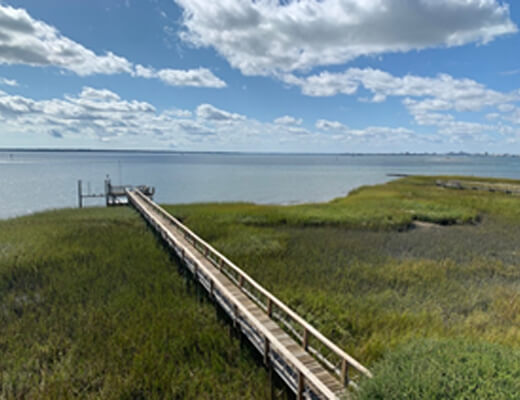
Heading inland up US 17, Charles Pinckney National Historic Site is part of an important Founding Father’s eighteenth century plantation, Snee Farm. In 1782, Charles Pinckney inherited Snee Farm and its enslaved population from his father (who bought it in 1754). He continued to grow rice and indigo there as an absentee landowner. Pinckney is best known as one of the authors of the U.S. Constitution and for serving as Jefferson’s Minister to Spain from 1801 to 1805.

A portrait of Charles Pinckney of Snee Farm. Library of Congress.
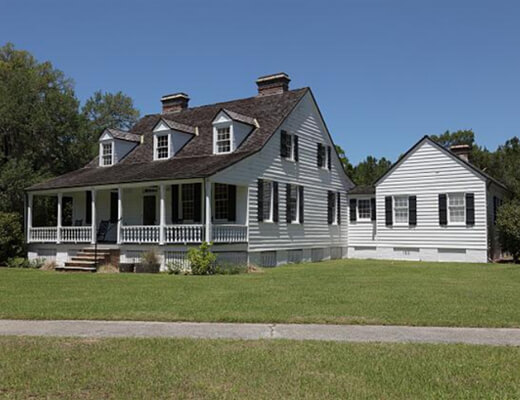
The Charles Pinckney House National Park Site. Library of Congress.
He used Snee Farm as a country retreat but owned many other plantations and a townhouse as well. The current vernacular timber frame house, with its dormer windows and cottage-like porch, was built in 1828 by Pinckney’s trustees who managed the site. Most of the plantation is now Snee Farm subdivision, but the park site has been operated by the National Park Service and open to visitors interested in history, coastal and Gullah culture, and coastal nature hiking since 1988.
Sports lovers living in Mount Pleasant have Joe Gawryck/Sloan Park with three lighted baseball fields and two batting tunnels and Mount Pleasant Recreational Center (with basketball courts and a pool), while boaters can put in at public landings at Remley’s Point, Shem Creek, and Paradise on Wando River. Hikers and nature lovers have over a dozen parks of various sizes to pick from. To highlight just three: Marshview Trail off of Rifle Range Road which is part of the East Cooper Land Trust’s network of protected sites, has paved walking trails for 57 acres of salt marshes and an oak lines hammock island. Palmetto Islands County Park near Boone Hall includes 943 acres with nature trails, a fifty-foot observation tour, a fishing and crab dock, playground, kayak rentals, and a picnic area in a subtropical setting of marshes and pinewoods. Laurel Hill Park just on the other side of Highway 41 in central Mount Pleasant includes 750 acres of running, walking, and biking trails approached by a historic oak allee and with views of open meadows and small inland lakes. Virtually any park site in Mount Pleasant has an important history as part of Christ Church Parish’s plantation district, and the lands along US 17 today are part of the Gullah Geechee Heritage Corridor.

A portrait of Charles Pinckney of Snee Farm.
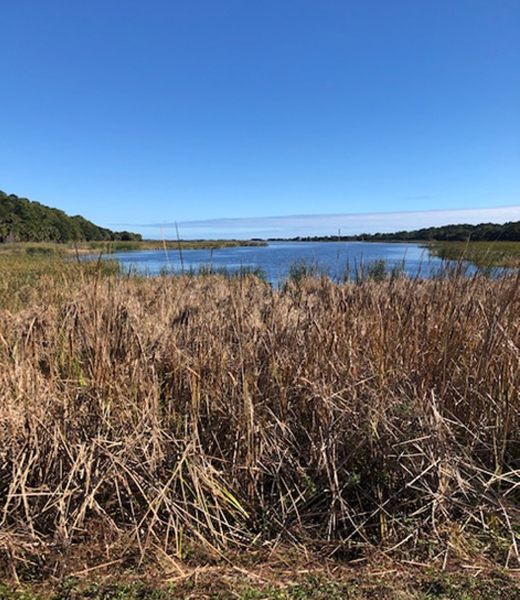
The Charles Pinckney House National Park Site.
Cape Romain National Wildlife Refuge and Bulls Island within it are just a few minutes beyond Mount Pleasant and offer a chance to step away from development into 66,000 acres of pristine, unpopulated coastal landscape. Cape Romaine Lighthouse, built in 1853 to replace an earlier building, is the focal point on the coastline when approaching the preserve from the ocean. Lightkeepers lived on site and manned the Fresnel lens light until the 1930s, when Lighthouse Island, Cape Island, Raccoon Key, and the surrounding marsh became the Cape Romain Migratory Bird Refuge, which has grown to include adjacent Bulls Island.
The Sewee Native American tribe called Bulls Island Oneiscau and created a surviving shell midden there as they hunted and fished the coastline. Stephen Bull claimed the island in 1670 as the English arrived in South Carolina and became its namesake. By 1925, it passed to U.S. Senator Gayer Dominick, who built the Dominick House on the island and used it as a winter retreat; he ultimately donated the land for conservation, and the house is now the center of the picnic area next to the ferry landing. Bulls Island has an expansive beach, a “boneyard” of driftwood, miles of hiking trails. There are alligators, dolphins, and sea turtle sites galore as well as 300 species birds, and because the island is only accessible through a ferry operated by Coastal Expeditions (who narrate the area’s history and ecology on the way and who offer guided kayak tours as well), visitors are guaranteed to have the beautiful landscape mostly to themselves.

An oak canopy at Palmetto Islands Park.
Sources:
- Town of Mount Pleasant Historical Commission, “Pierates Cruze,” Mount Pleasant Historical, accessed December 5, 2020, https://mountpleasanthistorical.org/items/show/49.
- News and Courier. “Pierate’s Cruze”, 15 February 1943.
- Susannah Smith Miles. “Hidden Treasure”, Charleston Magazine. https://charlestonmag.com/lost_treasure?fbclid=IwAR2JH1YoEbS6dAXN-0_VGq1G7v0DweORgLOVFd50vlVhm0452FXPyqbGTJQ
- Cape Romaine Lighthouse National Register.
- Lisa Weeks. East Cooper: A Maritime Heritage. Charleston: Arcadia Publishing, 2008.
- https://www.coastalexpeditions.com/bulls-island/ (accessed 6 December 2020).
- Tracy Pou. “Bulls Island”. Discover South Carolina. https://discoversouthcarolina.com/articles/bulls-island-where-the-beautiful-and-wild-things-are (accessed 5 December 2020).
- https://ccprc.com/69/Palmetto-Islands-County-Park (Accessed 5 December 2020).
- https://eastcooperland.org/portfolio-item/marsh-view-trail/ (Accessed 5 December 2020).
- David Quick, “Pierate’s Cruze”, Post and Courier, 28 January 1993.
- https://experiencemountpleasant.com/explore/shem-creek-park/ (Accessed 6 December 2020
- Roger Haddock. The Rudder. *: 1912
- South Carolina Department of Archives and History plats.
- Library of Congress photo and map collections.

